coolant RENAULT KANGOO 1997 KC / 1.G Engine And Peripherals Owner's Manual
[x] Cancel search | Manufacturer: RENAULT, Model Year: 1997, Model line: KANGOO, Model: RENAULT KANGOO 1997 KC / 1.GPages: 208
Page 156 of 208
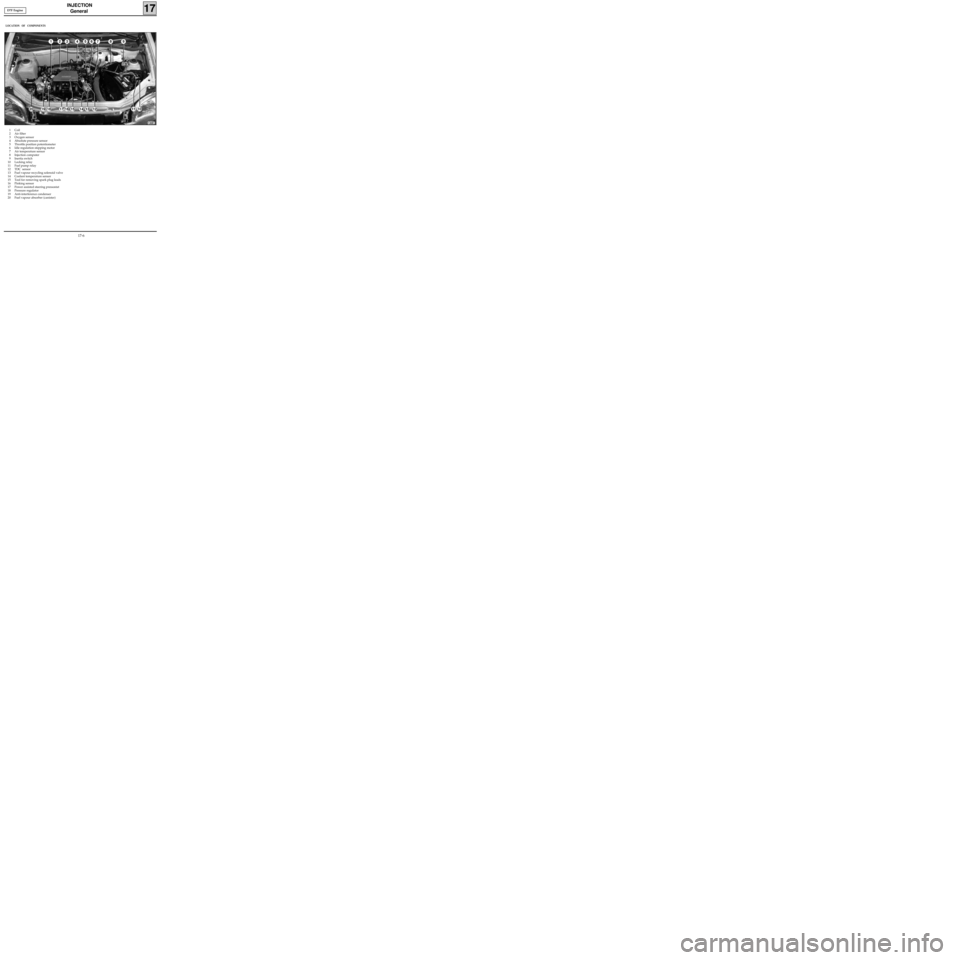
INJECTION
General
17
1 Coil
2 Air filter
3 Oxygen sensor
4 Absolute pressure sensor
5 Throttle position potentiometer
6 Idle regulation stepping motor
7 Air temperature sensor
8 Injection computer
9 Inertia switch
10 Locking relay
11 Fuel pump relay
12 TDC sensor
13 Fuel vapour recycling solenoid valve
14 Coolant temperature sensor
15 Tool for removing spark plug leads
16 Pinking sensor
17 Power assisted steering pressostat
18 Pressure regulator
19 Anti-interference condenser
20 Fuel vapour absorber (canister)
LOCATION OF COMPONENTS
13081
D7F Engine
17-6
Page 157 of 208
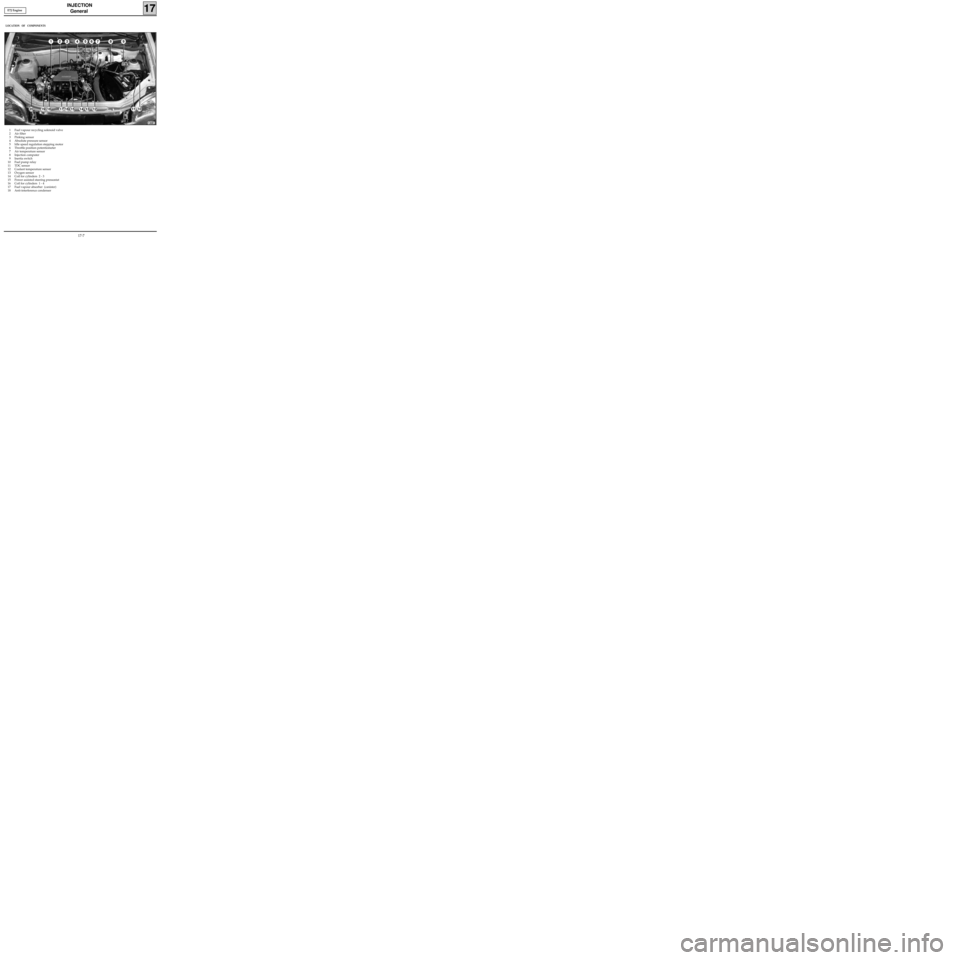
INJECTION
General
17
1 Fuel vapour recycling solenoid valve
2 Air filter
3 Pinking sensor
4 Absolute pressure sensor
5 Idle speed regulation stepping motor
6 Throttle position potentiometer
7 Air temperature sensor
8 Injection computer
9 Inertia switch
10 Fuel pump relay
11 TDC sensor
12 Coolant temperature sensor
13 Oxygen sensor
14 Coil for cylinders 2 - 3
15 Power assisted steering pressostat
16 Coil for cylinders 1 - 4
17 Fuel vapour absorber (canister)
18 Anti-interference condenser
LOCATION OF COMPONENTS
13082
E7J Engine
17-7
Page 158 of 208
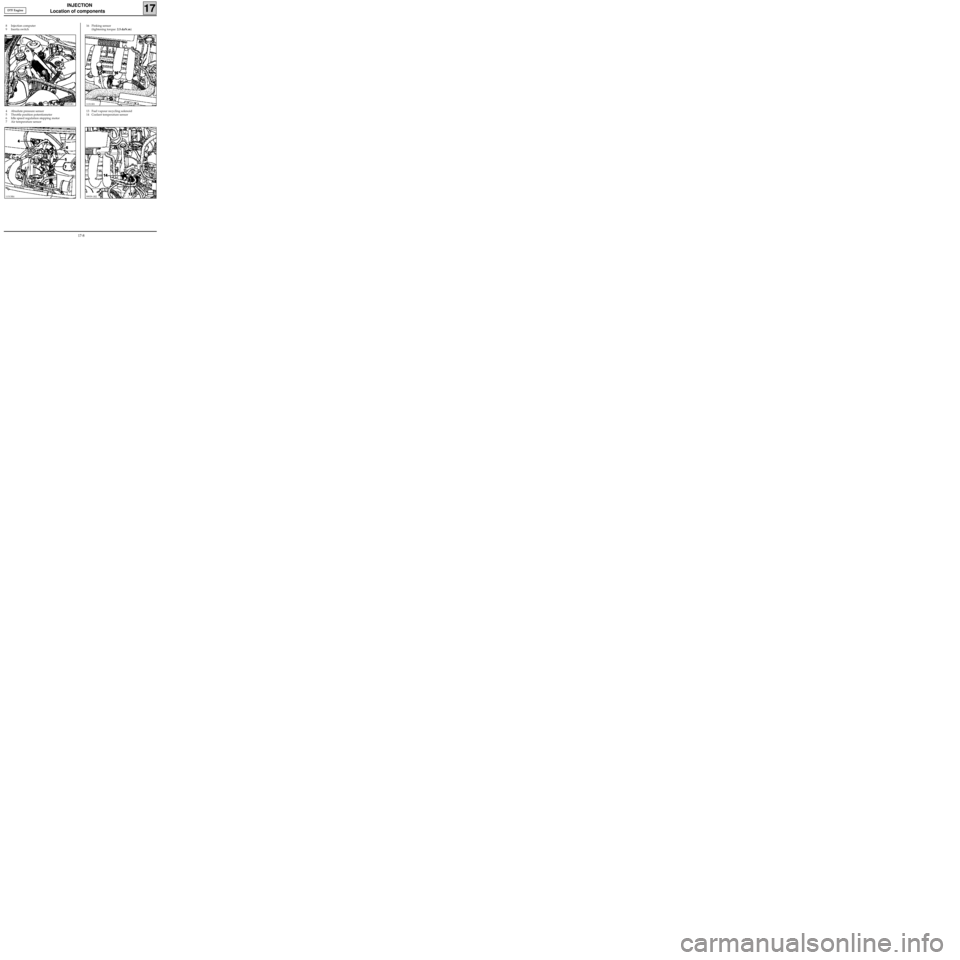
INJECTION
Location of components
17
4 Absolute pressure sensor
5 Throttle position potentiometer
6 Idle speed regulation stepping motor
7 Air temperature sensor13 Fuel vapour recycling solenoid
14 Coolant temperature sensor 16 Pinking sensor
(tightening torque: 2.5 daN.m)
11313R4
11311R1
99939-1R2
8 Injection computer
9 Inertia switch
13051R1
D7F Engine
17-8
Page 160 of 208

INJECTION
Location of components
17
12 Coolant temperature sensor8 Injection computer
9 Inertia switch
13240R
3 Pinking sensor
(tightening torque: 2.5 daN.m)
13336R13239R
E7J Engine
17-10
Page 163 of 208
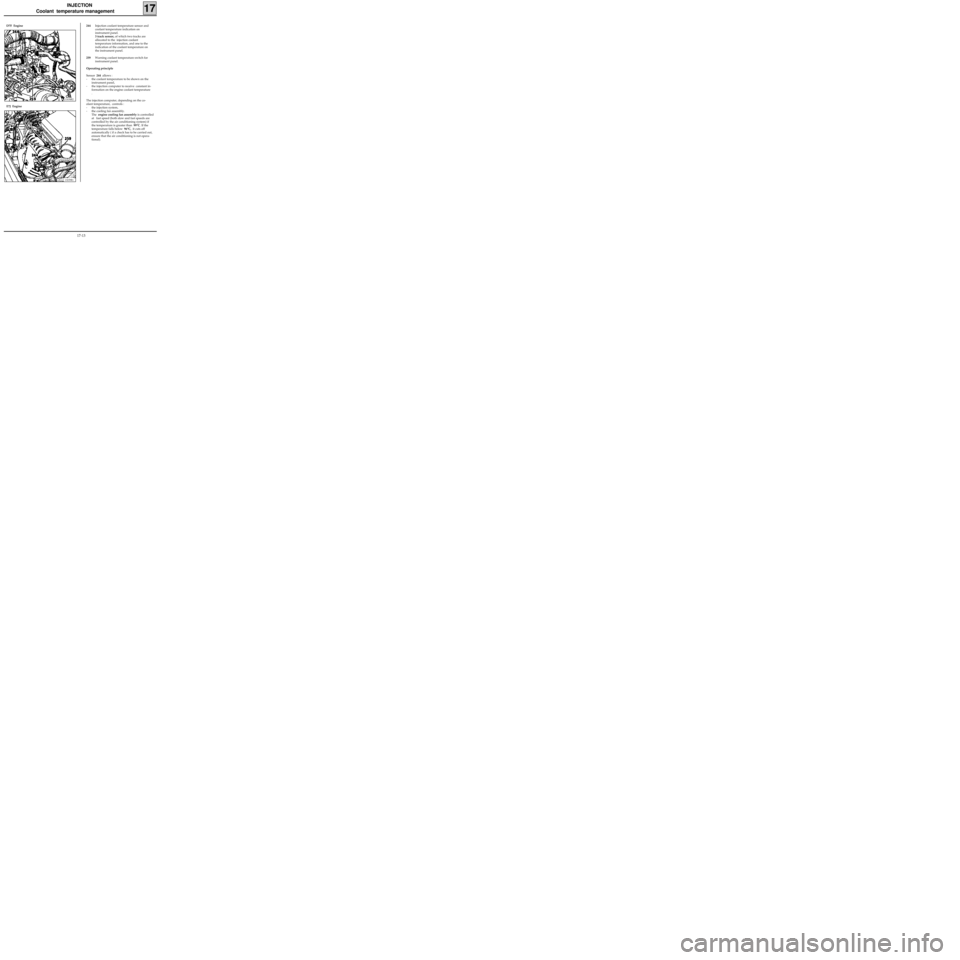
INJECTION
Coolant temperature management
244Injection coolant temperature sensor and
coolant temperature indication on
instrument panel.
3 track sensor, of which two tracks are
allocated to the injection coolant
temperature information, and one to the
indication of the coolant temperature on
the instrument panel.
259Warning coolant temperature switch for
instrument panel.
Operating principle
Sensor 244 allows :
- the coolant temperature to be shown on the
instrument panel,
- the injection computer to receive constant in-
formation on the engine coolant temperature
.
The injection computer, depending on the co-
olant temperature, controls :
- the injection system,
- the cooling fan assembly.
The engine cooling fan assembly is controlled
at fast speed (both slow and fast speeds are
controlled by the air conditioning system) if
the temperature is greater than 99°C. If the
temperature falls below 96°C, it cuts off
automatically ( if a check has to be carried out,
ensure that the air conditioning is not opera-
tional).
17
11634R2
D7F Engine
13239R1
E7J Engine
17-13
Page 167 of 208
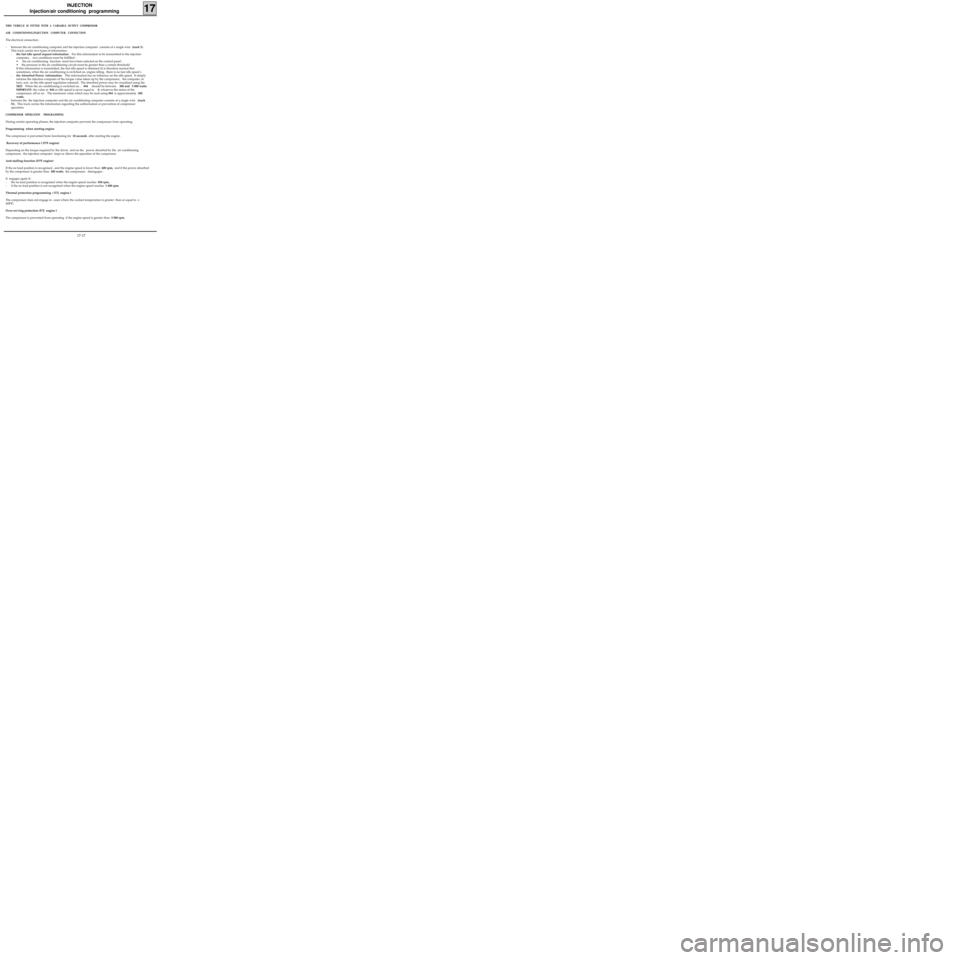
INJECTION
Injection/air conditioning programming
17
THIS VEHICLE IS FITTED WITH A VARIABLE OUTPUT COMPRESSOR
AIR CONDITIONING/INJECTION COMPUTER CONNECTION
The electrical connection :
- between the air conditioning computer and the injection computer consists of a single wire (track 5).
This track carries two types of information :
-the fast idle speed request information . For this information to be transmitted to the injection
computer , two conditions must be fulfilled :
• the air conditioning function must have been selected on the control panel ,
• the pressure in the air conditioning circuit must be greater than a certain threshold.
If this information is transmitted, the fast idle speed is obtained (it is therefore normal that
sometimes, when the air conditioning is switched on, engine idling, there is no fast idle speed ).
-the Absorbed Power information. This information has no influence on the idle speed. It simply
informs the injection computer of the torque value taken up by the compressor; the computer, in
turn, acts on the idle speed regulation solenoid. The absorbed power may be visualised using the
XR25. When the air conditioning is switched on , #44 should be between 300 and 5 000 watts.
IMPORTANT: the value at #44 or idle speed is never equal to 0, whatever the status of the
compressor, off or on . The minimum value which may be read using #44 is approximately 300
watts.
- between the the injection computer and the air conditioning computer consists of a single wire (track
51). This track carries the information regarding the authorisation or prevention of compressor
operation.
COMPRESSOR OPERATION PROGRAMMING
During certain operating phases, the injection computer prevents the compressor from operating.
Programming when starting engine
The compressor is prevented from functioning for 10 seconds after starting the engine .
Recovery of performance ( D7F engine)
Depending on the torque required by the driver and on the power absorbed by the air conditioning
compressor, the injection computer stops or allows the operation of the compressor .
Anti-stalling function (D7F engine)
If the no load position is recognised , and the engine speed is lower than 600 rpm, and if the power absorbed
by the compressor is greater than 300 watts, the compressor disengages .
It engages again if:
- the no load position is recognised when the engine speed reaches 850 rpm.,
- if the no load position is not recognised when the engine speed reaches 1 800 rpm.
Thermal protection programming ( E7J engine )
The compressor does not engage in cases where the coolant temperature is greater than or equal to +
115°C.
Over-revving protection (E7J engine )
The compressor is prevented from operating if the engine speed is greater than 5 900 rpm.
17-17
Page 169 of 208
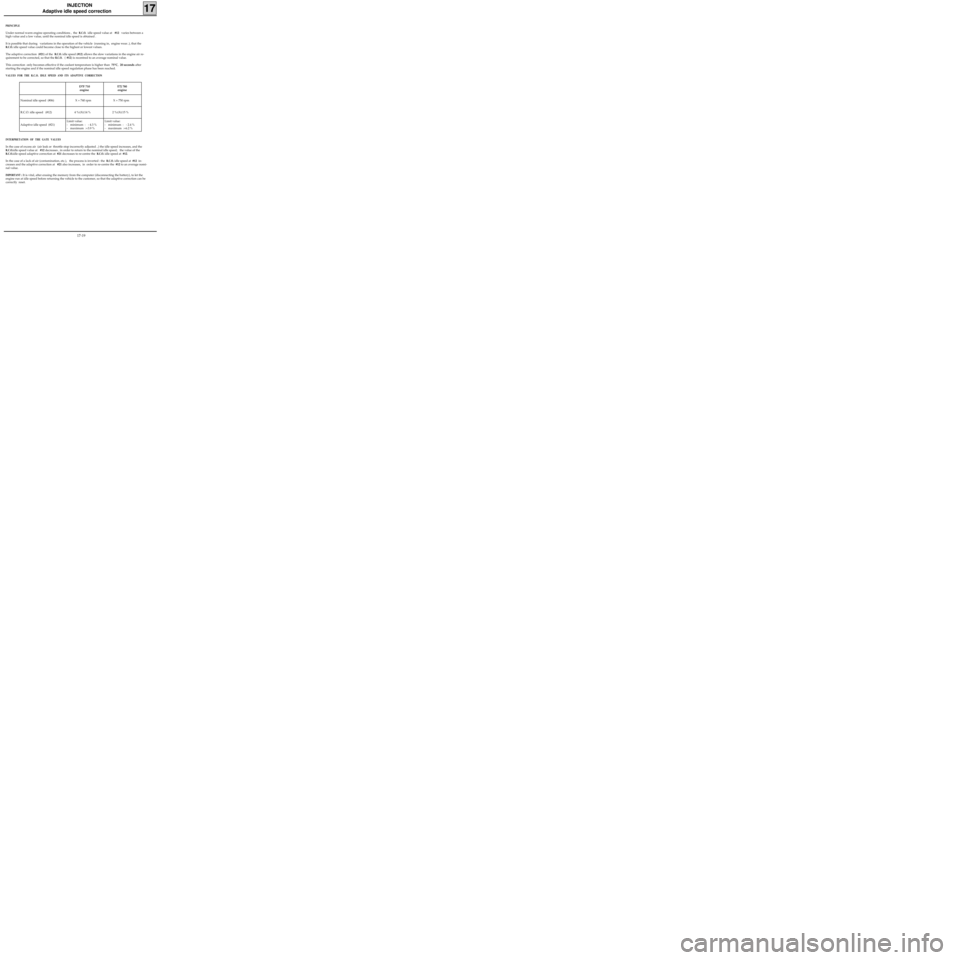
INJECTION
Adaptive idle speed correction
17
PRINCIPLE
Under normal warm engine operating conditions , the R.C.O. idle speed value at #12 varies between a
high value and a low value, until the nominal idle speed is obtained .
It is possible that during variations in the operation of the vehicle (running in, engine wear..), that the
R.C.O. idle speed value could become close to the highest or lowest values.
The adaptive correction (#21) of the
R.C.O. idle speed (#12) allows the slow variations in the engine air re-
quirement to be corrected, so that the
R.C.O. (#12) is recentred to an average nominal value.
This correction only becomes effective if the coolant temperature is higher than 75°C, 20 seconds after
starting the engine and if the nominal idle speed regulation phase has been reached.
VALUES FOR THE R.C.O. IDLE SPEED AND ITS ADAPTIVE CORRECTION
D7F 710
engineE7J 780
engine
Nominal idle speed (#06) X = 740 rpm X = 750 rpm
R.C.O. idle speed (#12) 4 %≤X≤14 % 2 %≤X≤15 %
Adaptive idle speed (#21)Limit value:
- minimum : - 4.3 %
- maximum :+3.9 %Limit value:
- minimum : - 2.4 %
- maximum :+6.2 %
INTERPRETATION OF THE GATE VALUES
In the case of excess air (air leak or throttle stop incorrectly adjusted ..) the idle speed increases, and the
R.C.O.idle speed value at #12 decreases , in order to return to the nominal idle speed; the value of the
R.C.O.idle speed adaptive correction at #21 decreases to re-centre the R.C.O. idle speed at #12.
In the case of a lack of air (contamination, etc.), the process is inverted : the
R.C.O. idle speed at #12 in-
creases and the adaptive correction at #21 also increases, in order to re-centre the #12 to an average nomi-
nal value.
IMPORTANT : It is vital, after erasing the memory from the computer (disconnecting the battery), to let the
engine run at idle speed before returning the vehicle to the customer, so that the adaptive correction can be
correctly reset.
17-19
Page 170 of 208
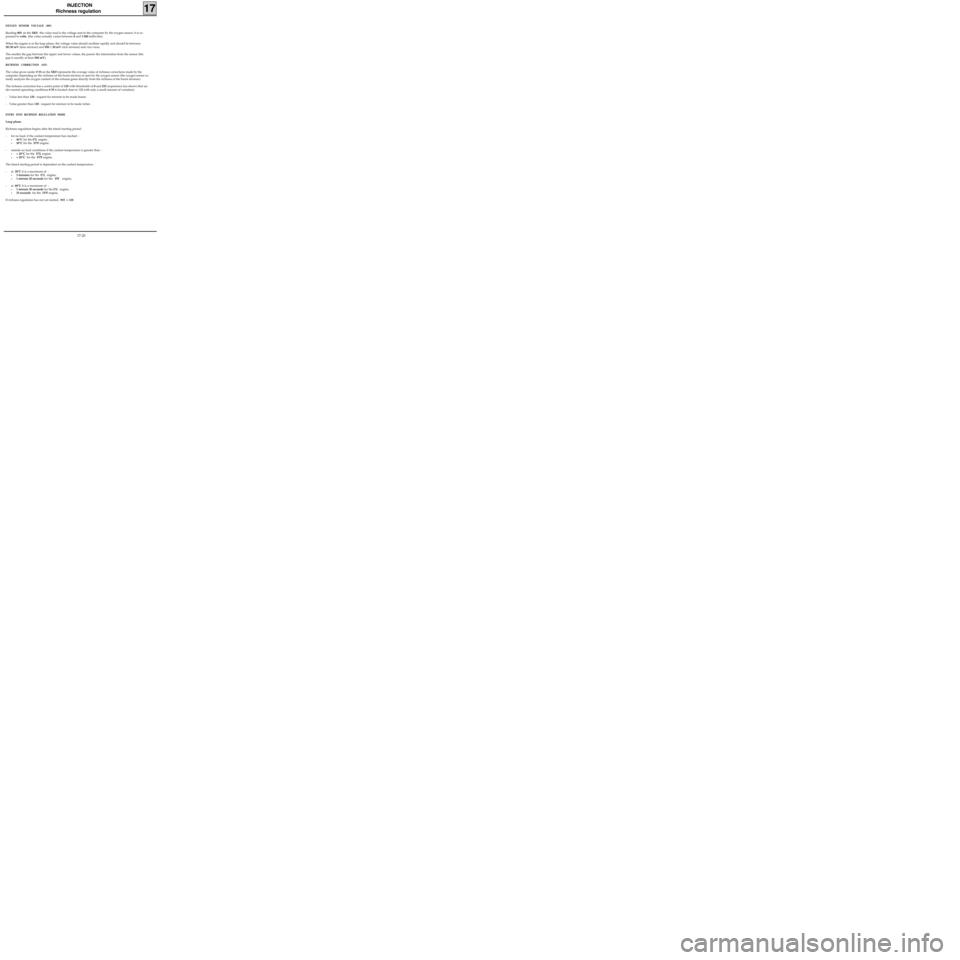
OXYGEN SENSOR VOLTAGE (#05)
Reading #05 on the XR25 : the value read is the voltage sent to the computer by the oxygen sensor; it is ex-
pressed in volts (the value actually varies between 0 and 1 000 millivolts).
When the engine is in the loop phase, the voltage value should oscillate rapidly and should be between
50±50 mV (lean mixture) and 850 ± 50 mV (rich mixture) and vice versa.
The smaller the gap between the upper and lower values, the poorer the information from the sensor (the
gap is usually at least 500 mV).
RICHNESS CORRECTION (#35)
The value given under # 35 on the XR25 represents the average value of richness corrections made by the
computer depending on the richness of the burnt mixture as seen by the oxygen sensor (the oxygen sensor ac-
tually analyses the oxygen content of the exhaust gases directly from the richness of the burnt mixture).
The richness correction has a centre point of 128 with thresholds of 0 and 255 (experience has shown that un-
der normal operating conditions # 35 is located close to 128 with only a small amount of variation).
- Value less than 128 : request for mixture to be made leaner.
- Value greater than 128 : request for mixture to be made richer.
ENTRY INTO RICHNESS REGULATION MODE
Loop phase
Richness regulation begins after the timed starting period :
- for no load, if the coolant temperature has reached :
•46°C for the E7J engine ,
•30°C for the D7F engine.
- outside no load conditions if the coolant temperature is greater than :
•+ 20°C for the E7J, engine
•+ 20°C for the D7F engine.
The timed starting period is dependent on the coolant temperature :
- at 20°C it is a maximum of :
•3 minutes for the E7J engine,
•1 minute 20 seconds for the D7F engine,
- at 80°C it is a maximum of :
•1 minute 30 seconds for the E7J engine,
•35 seconds for the D7F engine,
If richness regulation has not yet started, #35 = 128
INJECTION
Richness regulation
17
17-20
Page 173 of 208
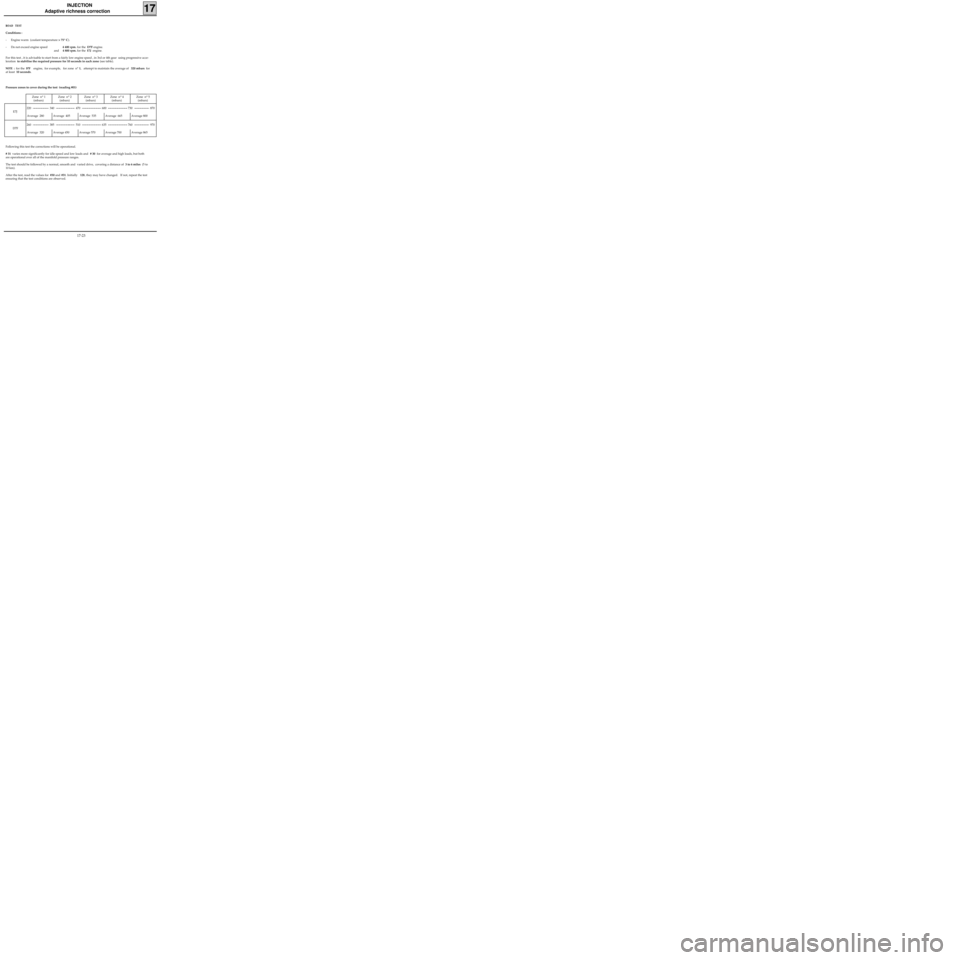
INJECTION
Adaptive richness correction
17
Zone n° 5
(mbars)Zone n° 4
(mbars)Zone n° 3
(mbars)Zone n° 2
(mbars)Zone n° 1
(mbars)
220340470 600 730870
Average 280 Average 405 Average 535 Average 665 Average 800
260385510 635 760970
Average 320 Average 450 Average 570 Average 700 Average 865
E7J
D7F Pressure zones to cover during the test (reading #01)
Following this test the corrections will be operational.
# 31 varies more significantly for idle speed and low loads and # 30 for average and high loads, but both
are operational over all of the manifold pressure ranges.
The test should be followed by a normal, smooth and varied drive, covering a distance of 3 to 6 miles (5 to
10 km).
After the test, read the values for #30 and #31. Initially 128, they may have changed. If not, repeat the test
ensuring that the test conditions are observed.
ROAD TEST
Conditions :
- Engine warm (coolant temperature > 75° C).
- Do not exceed engine speed 4 400 rpm. for the D7F engine.
and 4 800 rpm. for the
E7J engine.
For this test , it is advisable to start from a fairly low engine speed , in 3rd or 4th gear using progressive acce-
leration to stabilise the required pressure for 10 seconds in each zone (see table).
NOTE : for the D7F engine, for example, for zone n° 1, attempt to maintain the average of 320 mbars for
at least 10 seconds.
17-23
Page 175 of 208
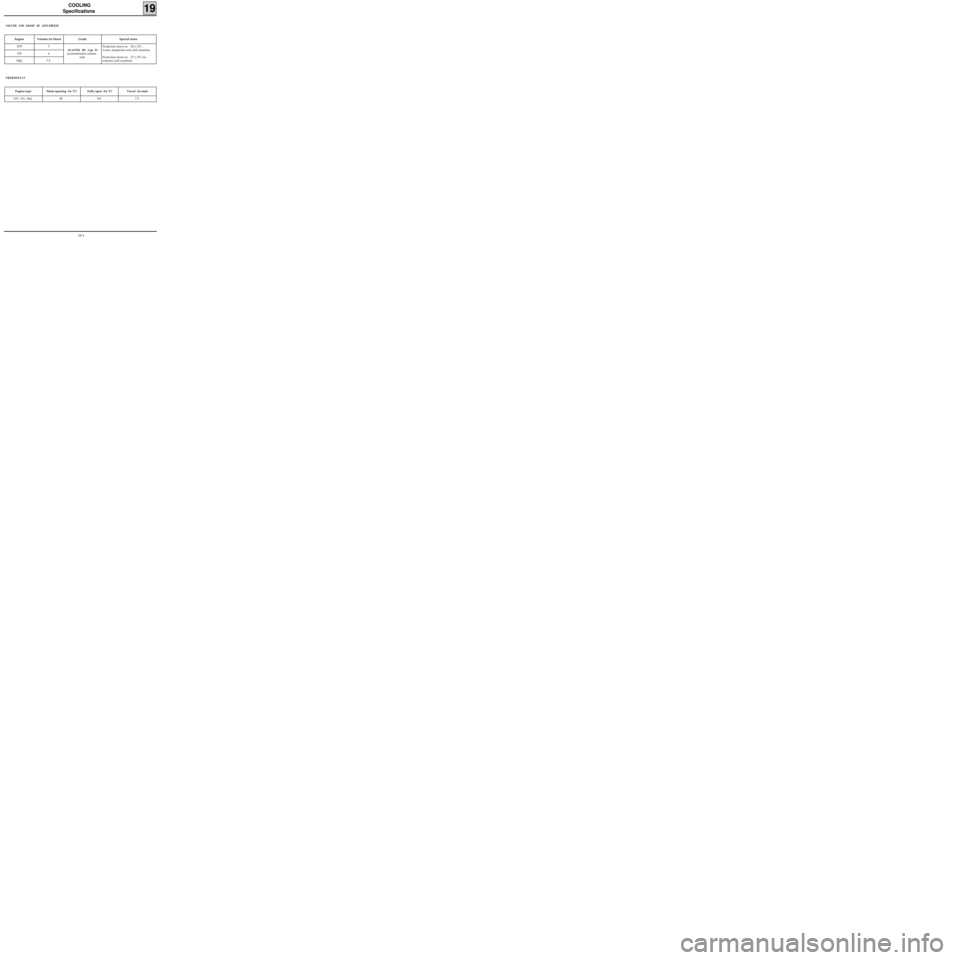
COOLING
Specifications
19
VOLUME AND GRADE OF ANTI-FREEZE
Engine Volume (in litres) Grade Special notes
D7F
E7J
F8Q5
6
7.5
GLACEOL RX (type D)
recommended coolant
onlyProtection down to - 20 ± 2°C ,
warm, temperate and cold countries
Protection down to - 37 ± 2°C for
extreme cold countries
THERMOSTAT
Engine type Starts opening (in °C) Fully open (in °C) Travel (in mm)
D7F - E7J - F8Q89 101 7.5
19-1